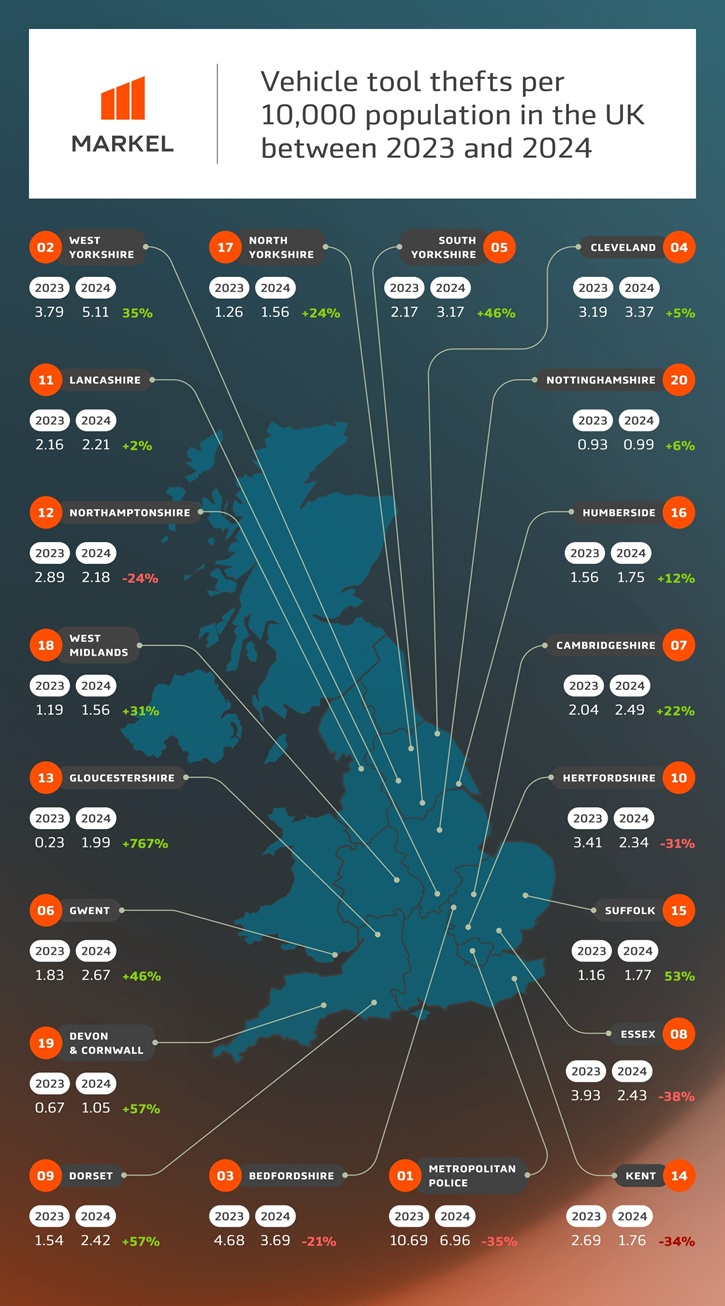UK DIY News
Tool Theft Bill Gains Momentum As New Data Reveals UK’s Most Targeted Areas

Tool theft has affected tradespeople and the construction sector for a long time – however, in recent years, legislation has been passed through parliament to act as a deterrent to would-be thieves. These include the Equipment Theft (Prevention) Act 2023 and - more recently - the Theft of Tools of Trade (Sentencing) Bill, which is now due to receive its second reading on the 31st October 2025, pushed back from the original date which was in July.
The purpose of the Bill is to increase the sentencing category for criminals convicted of the theft of tools of trade.
Currently, tool theft is categorised as ‘harm category 3’, because most instances of theft are of a value under £10,000.
The Bill proposes that tool theft should be reclassified as causing ‘significant additional harm’ to the victim of the theft, which would enable magistrates to increase the severity of the offence to ‘harm category 2’ when it comes to the sentencing – even if the value of the theft is under £10,000.
Additionally, the Bill is looking to standardise the calculation of financial loss to include not only the physical cost of the tool itself, but the additional costs that often come with tool theft such as:
- The cost of repairs to any vehicle from which the tools were stolen – such as fixing damage to a van’s locks
- Loss of earnings resulting from the theft – such as being unable to work
- The cost of any interruption of business resulting from the theft – such as being unable to fulfil a contract
Tradespeople back tougher sentences for tool thieves
A recent survey asked tradespeople if they would support the introduction of the Theft of Tools of Trade (Sentencing) Bill. An overwhelming 91% of respondents answering that they would.
Rob Rees, Divisional Director at Markel Direct, said: “Our study shows how prevalent and detrimental tool theft is to the trades and construction industry. It’s impacting the livelihoods of tradespeople across the UK, with no location for storing tools completely safe from being targeted by thieves. We welcome new legislation, which aims to reclassify tool theft to a higher sentencing category, acting as a stronger deterrent to would-be thieves.”
Amanda Martin, Labour MP for Portsmouth North, and sponsor of the Theft of Tools of Trade Bill, said: “It’s no surprise that 91% of tradespeople back this bill, tool theft is one of the biggest issues they face. This overwhelming support shows how urgent and widespread the problem is. Too often, sentencing is not reflecting the true harm these thefts cause. I am campaigning to put victims at the heart of sentencing and to ensure courts treat tool theft with the seriousness it deserves, moving these cases to higher harm categories and imposing sentences, whether custodial or community, that truly deter criminals and reduce the number of victims.”
Police force data reveals the most targeted areas for tool thefts from vans

A new study by Markel Direct, the specialist insurer of tradespeople, has revealed the UK’s tool theft hotspots.
The study, which explores the impact of tool theft on the construction sector of tool theft, obtained data from UK police forces through a Freedom of Information request to identify which locations experienced the most instances of tools being stolen from vans and other vehicles.
The Metropolitan police force topped the list, with the highest number of tool thefts from vehicles with 6.96 thefts per 10,000 population. In second place was West Yorkshire, which reported 5.11 tool thefts per 10,000 population and was followed in third spot by Bedfordshire, who reported 3.69 tool thefts per 10,000 population. The data highlights that tool theft isn’t a localised problem and is prevalent across all of the UK.
Police forces with the most tool thefts from vehicles per 10,000 population*
Police force area | Vehicle tool thefts per 10,000 pop 2024 |
Metropolitan Police | 6.96 |
West Yorkshire | 5.11 |
Bedfordshire | 3.69 |
Cleveland | 3.37 |
South Yorkshire | 3.17 |
Gwent | 2.67 |
Cambridgeshire | 2.49 |
Essex | 2.43 |
Dorset | 2.42 |
Hertfordshire | 2.34 |
Lancashire | 2.21 |
Northamptonshire | 2.18 |
Gloucestershire | 1.99 |
Kent | 1.78 |
Suffolk | 1.77 |
Humberside | 1.75 |
North Yorkshire | 1.56 |
West Midlands | 1.56 |
Devon and Cornwall | 1.05 |
Nottinghamshire | 0.99 |
Derbyshire | 0.82 |
Norfolk | 0.71 |
Cumbria | 0.68 |
Avon and Somerset | 0.54 |
Lincolnshire | 0.43 |
Surrey | 0.40 |
North Wales | 0.36 |
* Out of 46 forces contacted, 27 provided the necessary data.
The study revealed that vehicles were a popular target for thieves, with an alarming 35% occurring whilst the tradesperson’s vehicle was parked on site, 29% at home and 22% in public car parks. Eighteen percent of thefts happened when the tradesperson’s tools were stored in an outbuilding (e.g. a shed or garage), whilst 7% occurred when the tools were in their home, highlighting that no location for storing tools is completely safe from being targeted by thieves.
The study also explored the times of the year when tool theft from vehicles was most prolific. In 2024, January saw the highest recorded number of cases reported, followed in second place by April and February taking third spot. The data indicates its worthwhile for tradespeople to be more proactive with their safety measures during these months, where we experience darker mornings and evenings in the UK.
To read the full study, visit the Markel Direct website.
You can find out more about the Theft of Tools of Trade (Sentencing) bill here: https://bills.parliament.uk/bills/3908/stages
Source : Markel Direct
Image : Sinenkiy / iStock / 1501145625
<!--EndFragment-->
Insight DIY always publishes the latest news stories before anyone else and we find it to be an invaluable source of customer and market information.











































